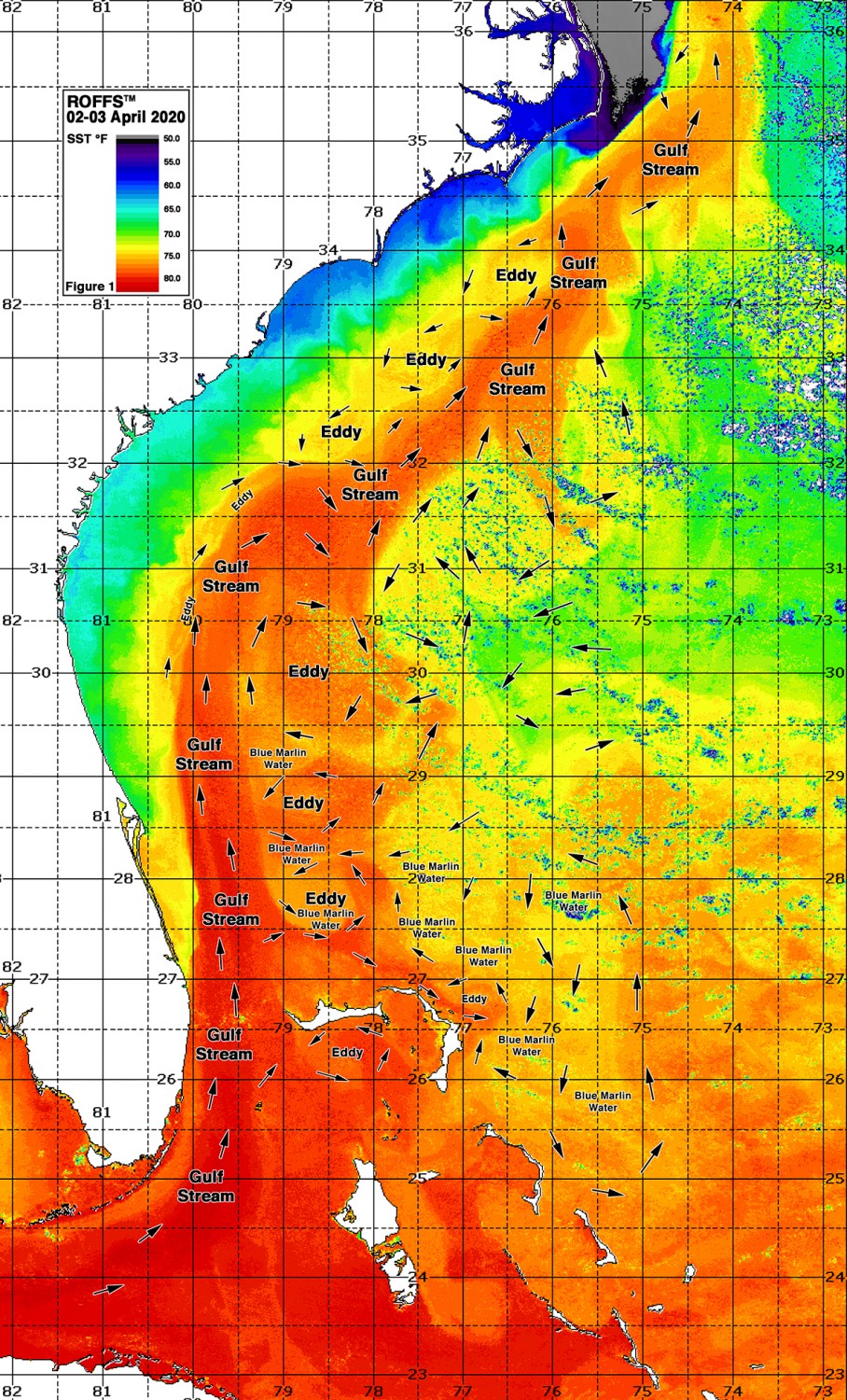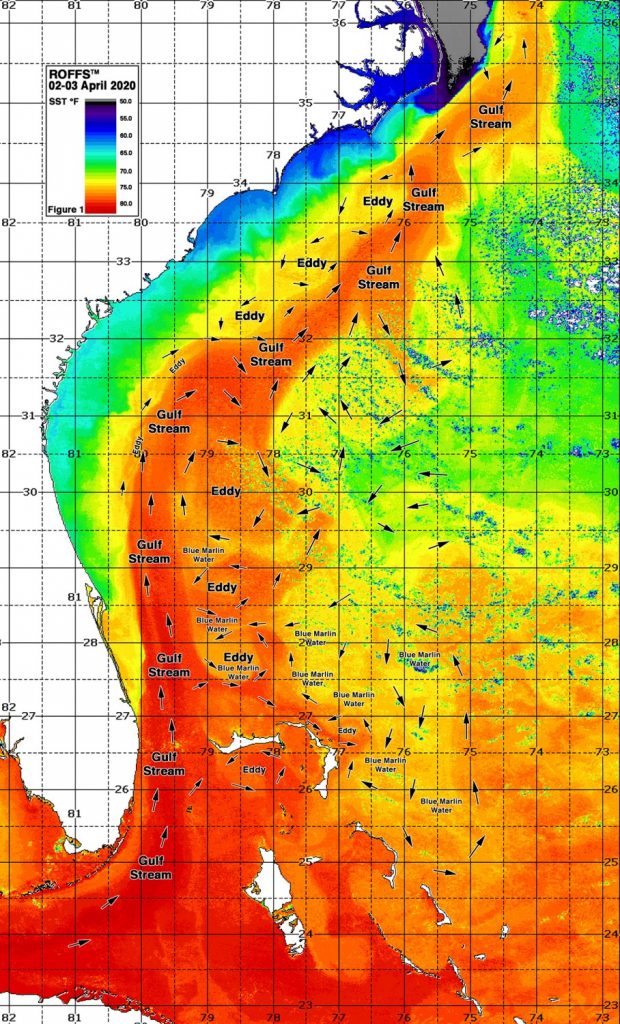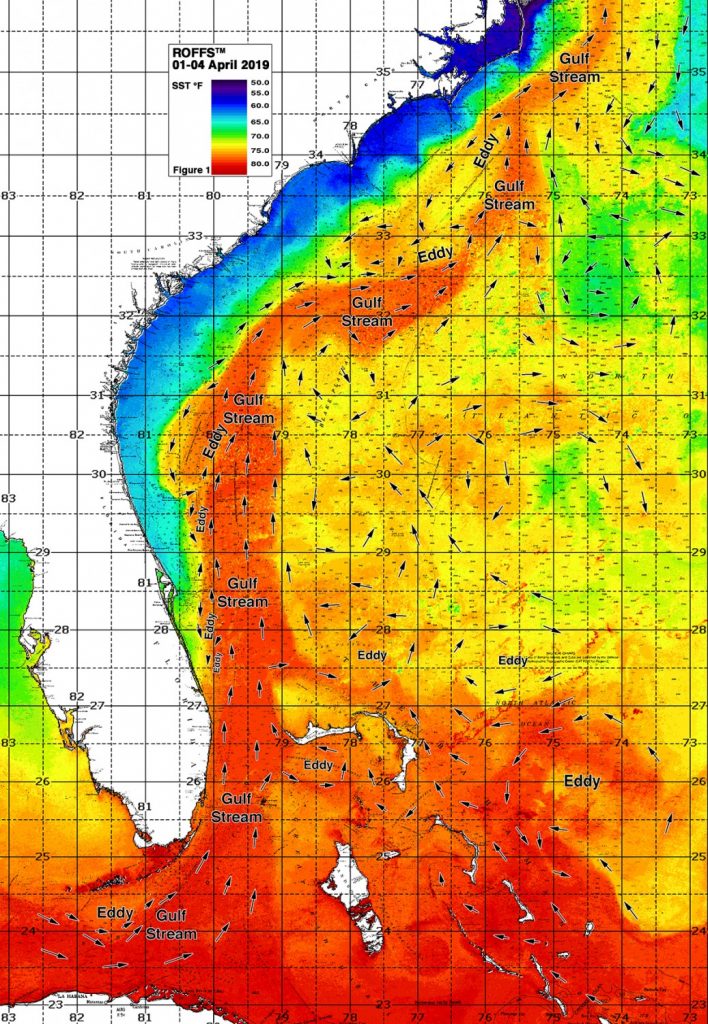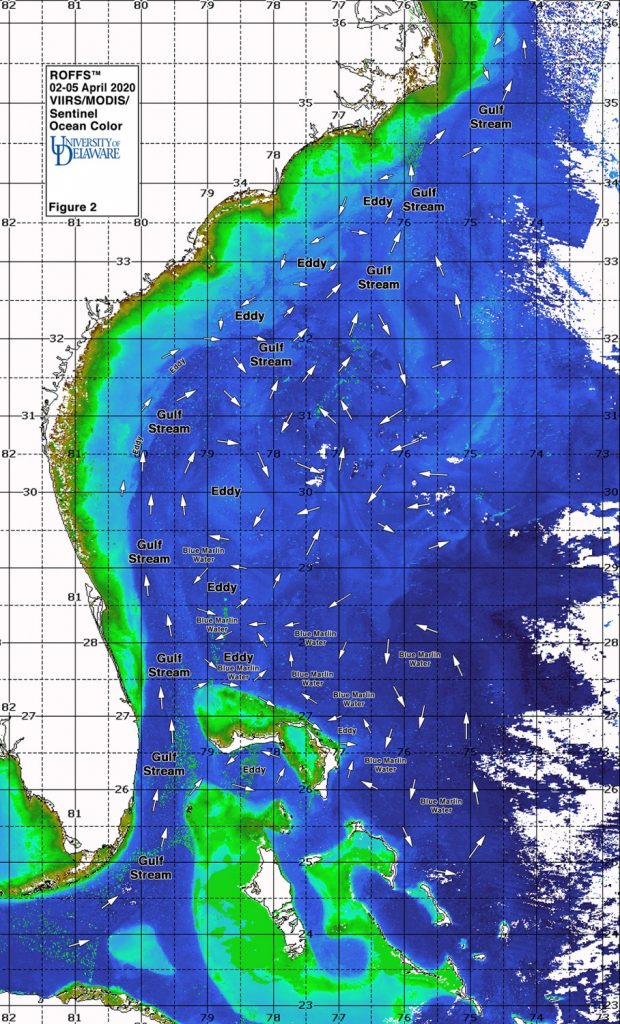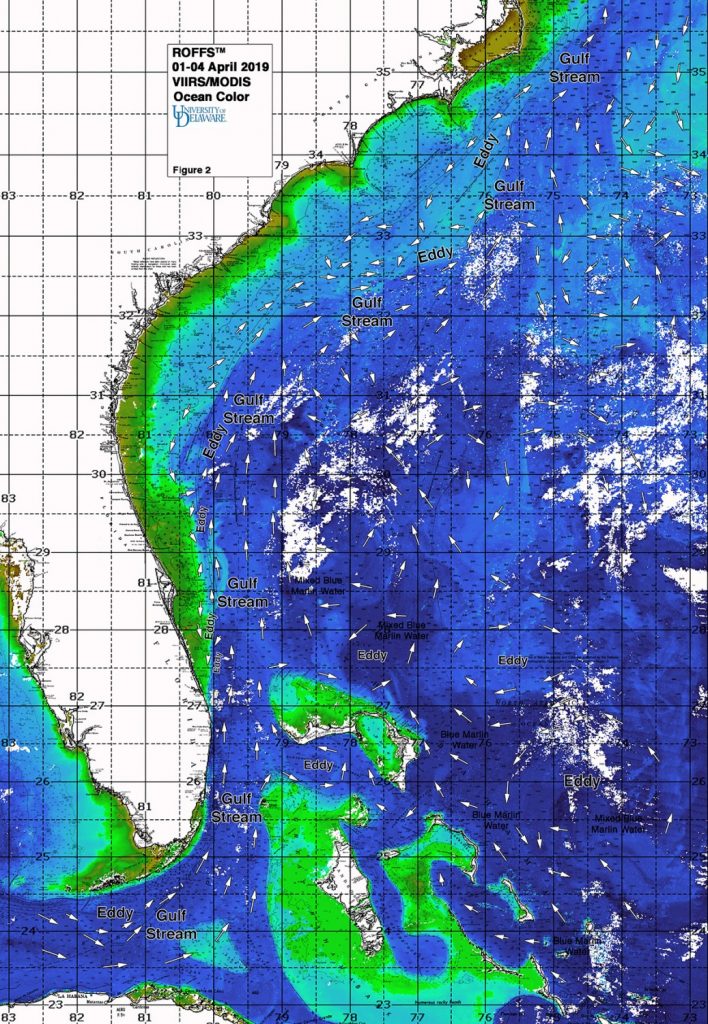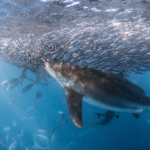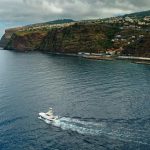Please click here to view full 2020 ROFFS™ South Season Fishing Forecast as a PDF.
Southern Florida to Cape Hatteras Spring Season Preview 2020: UPDATE ON U.S. EAST COAST GULF STREAM CONDITIONS
By ROFFS™ | James L. W. King
Although we are all having challenges due to Coronavirus (COVID-19) and related restrictions, ROFFS™ will continue to remain open. Everyone is working from home and isolated while we continue to provide the same quality service and products throughout this year, including our valued customer support. Remember, one of the safest places to be is offshore on the water, as the ocean remains open as well.
ROFFS™ continues its spring preview series by providing an overall update of the oceanographic conditions during early April for the east coast of the United States from the Florida Keys north to Cape Hatteras, NC including the entire offshore Gulf Stream region. As always, we have used a combination of many different data sets, but mainly sea surface temperature (SST) and ocean color/chlorophyll images. We will discuss these overall ocean conditions for the present spring season and how these conditions may translate to the near future fishing season.
For forecasting short-term oceanographic conditions related to finding fish, ROFFS™ uses real-time direct satellite observations rather than unproven ocean models and longer-term composites. We have learned that evaluating the pre-season conditions, along with regional climate models, provides insight into future seasonal trends for fishing. Experience and understanding of the ocean – atmospheric dynamics is our guide as we have had moderate success in forecasting seasonal trends of fishing productivity based on the stepwise progression in the location of the fishes’ preferred habitat, based on temperature and water color. Please reference our 2020 Bahamas forecast for more in-depth discussion on the environmental and climate indicators that goes into our detailed evaluation of the southeastern United States fishing forecasting analysis (Click Here).
Background and Some Observations for 2020
It is important to look at the year-to-year trends including the anomalies to gain insight into the location and condition of the fishes’ preferred habitat compared with previous years. Comparing similar locations and features to last year during the same early April time period we found that the SST of the core of the Gulf Stream off of Miami, FL for 2019 was approximately 79.6°F and for this year it is approximately 1.0°F warmer at approximately 80.5°F. Offshore of Jacksonville, FL the SST of the core of the Gulf Stream appears to be approximately 79.6°F which is similar to the SST from 2019. However, these conditions were the result of a recent cold front that reduced the overall SST from Jacksonville to Cape Hatteras. The period before this front passed through, the core of the Gulf Stream experienced SST as high as 79.8°F-80.1°F. That being said, parts of February and much of March, the core of the Gulf Stream spent much of its time further offshore than it did in 2019. Relatively large Gulf Stream eddy formations off of Cape Fear to Cape Hatteras have kept the core of the Gulf Stream offshore for parts of February and all of March. Unlike last year, there were fewer Gulf Stream filaments along the northwestern edges of these eddy formations bringing warmer water inshore. This is in contrast to some of the larger filaments that brought Gulf Stream water further inshore in 2019.
Continuing north, the SST from Charleston, SC to Cape Hatteras within the core of the Gulf Stream was similar between early April 2019 and 2020 at approximately 78.5°F. However, the western edges of the Gulf Stream were located approximately 80-90 miles southeast between Georgetown, SC and Cape Fear before moving back over the 100 fathom ledges of Cape Lookout for half of February and all of March. Compare this to 2019 when a large, but fast moving eddy only pushed the Gulf Stream offshore for 15 days during this similar time period. This kept the core of the Gulf Stream and associated maximum currents farther offshore since mid February 2020, between Charleston, SC to east of Cape Fear. Additionally, the eastern side of the Gulf Stream north of the Bahamas has been less stable than last year with several large, counter-clockwise rotating cold-core eddy formations developing east of Cape Canaveral and moving northwards.
Nowcast Analysis
The Gulf Stream Current, including its related eddies and filaments along the current’s eastern and western side are the preferred habitat of the highly migratory species for this time of year and are the most important conditions that we are studying. It is the day-to-day and hour-to-hour movements of these Gulf Stream related features that are important to monitor when deciding where to fish on a daily basis. Although we are only showing a two-to-three-day snap shot of the conditions in this report from early April (Figure 1a/b and 2a/b), we can discuss briefly the trends we see based on these early spring oceanographic conditions and related fishing reports that may provide insight into the near-future fishing season.
Figures 1a/b were derived from a variety of U.S. and European satellites during the early April (April 02-03, 2020 and April 01-04, 2019) period and Figures 2a/b were derived from U.S. SNPP VIIRS, Aqua/Terra MODIS ocean color/chlorophyll, and European Space Agency’s Sentinel 3 imagery during this same period (April 02-05, 2020 and April 01-04, 2019). As the exact values of the original data from different satellite sensors (VIIRS, MODIS and Sentinel) are not the same, we cross-calibrated the data to derive images that have realistic and consistent watercolor. This is one of the many techniques that we derived during the valuable NASA Earth Science Program projects that ROFFS™ has been involved with. We cannot over-stress the importance of NASA’s Earth Science Program and the Ocean Biology Processing Group for helping to understand the ocean’s dynamic ecosystem and how it impacts food security, homeland security and land-ocean interactions.
Figure 1a: This year’s Florida Keys to Cape Hatteras, NC conditions were derived from a variety of infrared sensors to get SST from NASA, NOAA, JPSS and ESA satellites during April 02-03, 2020. Main features and surface currents are labeled.
Figure 1b: Last year’s Florida Keys to Cape Hatteras, NC conditions were derived from a variety of infrared sensors to get SST from NASA, NOAA, JPSS and ESA satellites during April 01-04, 2019. Main features and surface currents are labeled.
Figure 2a: This year’s Florida Keys to Cape Hatteras, NC conditions derived from the ocean color/chlorophyll imagery during April 02-05, 2020 from the VIIRS sensors on SNPP satellite and the Aqua and Terra sensors on the MODIS satellite provided by University of Delaware in combination with Sentinel 3 from ESA. We consider this an image pair with the above SST Figure 1a image. Same main features and surface currents labeled.
Figure 2b: Last year’s Florida Keys to Cape Hatteras, NC conditions derived from the ocean color/chlorophyll imagery during April 01-04, 2019 from the VIIRS sensors on SNPP satellite in combination with the Aqua and Terra sensors on the MODIS satellite provided by University of Delaware. We consider this an image pair with the above SST Figure 1a image. Same main features and surface currents labeled.
We were able to use imagery from April 2nd-5th for this year’s analysis. The directional flow of the water was derived from our ROFFS™ sequential image analysis, following the water image to image based on the water masses distinct, i.e. signature value. An example of this years SST satellite infrared imagery in greytone can be found on the ROFFS™ YouTube™ site (Click Here). Viewing the movie will allow one to follow the flow of the water and numerous eddies within the Gulf Stream region from offshore of eastern and southern Florida to North Carolina during the last month, where the darker greytoned water represents the warmer water and white indicates clouds.
Conclusion
Based on what we have been observing over the last several weeks, the present overall early April ocean conditions (SST) for the Gulf Stream region between the Florida Keys to Cape Hatteras, NC appears similar to what we had observed last year. However, regional variations were observed. The SST of the core of the Gulf Stream off of Miami was slightly warmer, likely resulting in the good numbers of dolphin, wahoo, sailfish, and marlin experienced within the last one to two weeks in that area. Inshore waters north of Cape Canaveral have observed higher temperatures than last year (from 2°F-4°F warmer than 2019). This may also support the recent wahoo action off of Jacksonville and St. Augustine. However, there hasn’t been a substantial increase in wahoo action off Georgia and the Carolinas yet and dolphin fishing from North Florida and Georgia has been slower than similar periods in previous years. This suggests that the majority of the population of dolphin will soon arrive and start to migrate north using the Gulf Stream as its guide later in April and into May as per normal. This means that, if your local authorities allow, you should be either fishing already or your boat should be in the water waiting for that weather window. We want you to take advantage of the good ocean conditions and the positive reports we have received recently. Once the water continues to warm after the last of the seasonal cool fronts pass through, the offshore fishing season will continue to improve off of Cape Canaveral to Cape Hatteras for tuna, wahoo, marlin and mahi mahi. It will not be long until the main migration of marlin, yellowfin tuna and mahi will be available off of North and South Carolina. We have already gotten multiple reports of good tuna, marlin, mahi mahi and sailfish action off of eastern Florida, especially along the eastern side of the Stream. There have also been a few wahoo caught off of South Carolina and Georgia. Earlier this year, the Florida Keys saw good sailfish action that transitioned into good blackfin tuna and some wahoo in mid-February and early March.
It is important to note that good fishing action on a daily basis is strongly linked to local, short-term (days) current conditions that concentrate the fish once the preferred habitats of the fish are in a particular region. When the water mass boundaries associated with these currents are geographically stable and favorable, i.e., persistently pushing over “good” bottom topography and/or in a favorable inshore direction, then they concentrate the baitfish and larger fish can be found foraging. Relatively short-term (hourly/daily) and relatively small-scale (1-10 mile) movements of the currents and their associated water mass boundaries are often in control of the level of fishing productivity on any given day. Our experience indicates that to reliably forecast specific concentrations of fish on a daily basis one must evaluate the ocean conditions on these scales. Relatively small subtle changes in the currents and their associated water mass boundary zones often have dramatic effects on the distribution and concentration of fish.
The Gulf Stream conditions change rapidly along the Gulf Stream areas so it becomes even more important to contact ROFFS™ (321.723.5759 / fishing@roffs.com / roffs.com) for the daily up-to-date detailed fishing forecasting analyses and get the inside track to where the better conditions will be tomorrow. We continue to monitor the coastal southeastern U.S. Ocean conditions especially the Gulf Stream and its related eddy features and how it relates to the local fishing environment as the larger recreational and tournament fishing season approaches. Get out and fish now and maximize your fishing experience by using ROFFS™ to locate the good spring conditions near you. If you are able, fish now as the good fishing conditions off of the Southeast U.S. has begun and is continuing. We hope that in May the COVID-19 cases stabilize and start declining, and restrictions on travel, marinas and tournaments will lift. However, we also understand that the safety and health of our clients and employees come first.
Safe and Successful Fishing from ROFFS™
[/et_pb_text][/et_pb_column][/et_pb_row][/et_pb_section]
